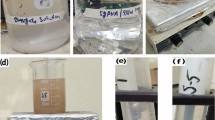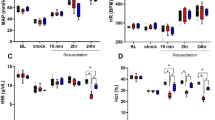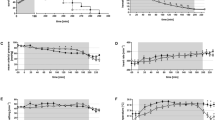Abstract
Polyhemoglobin-superoxide dismutase-catalase is designed to function as an oxygen carrier with antioxidant properties. This is based on cross-linking hemoglobin with superoxide dismutase and cata-lase (PolyHb-SOD-CAT). This study describes the structural and antioxidant properties of this solution. Our studies show that superoxide dismutase and catalase retain their enzymatic activity following glu-taraldehyde polymerization with 8:1 and 16:1 glutaraldehyde:hemoglobin ratio. We have analyzed the optimal SOD/CAT ratios to prevent oxidation of hemoglobin in the presence of oxygen free radicals. The circulation half-life of crosslinked hemoglobin, SOD, and catalase in Sprague-Dawley rats correlates with the degree of polymerization as determined by high-performance molecular weight gel filtration. PolyHb-SOD-CAT decreases the formation of oxygen radicals compared with PolyHb in a rat intestinal ischemia-reperfusion model.
This is a preview of subscription content, access via your institution
Access options
Subscribe to this journal
Receive 12 print issues and online access
$209.00 per year
only $17.42 per issue
Buy this article
- Purchase on Springer Link
- Instant access to full article PDF
Prices may be subject to local taxes which are calculated during checkout
Similar content being viewed by others
References
Chang, T.M.S. 1997. Blood substitutes: principles, methods, products and clinical trials, Vol. I. Karger, Basel, Switzerland.
Gould, S.A. and Moss, G.S. 1996. Clinical development of human polymerized hemoglobin as a blood substitute. World J. Surg. 20: 1200–1207.
Chang, T.M.S. (ed.). 1998. Blood substitutes: principles, methods, products and clinical trials, Vol. II. Karger, Basel, Switzerland.
Winslow, P.M. 1996. Blood substitutes in development. Exp. Opin. Invest. 5: 1443–1452.
Fransen, E.J., Maessen, J.G., Hermens, W.T., and Glatz, J.F. 1998. Demonstration of ischemia-reperfusion injury separate from postoperative infarction in coronary artery bypass graft patients. Ann. Thorac. Surg. 65: 48–53.
Bowler, J.V., Wade, J.P., Jones, B.E., Nijran, K.S., and Steiner, T.J. 1998. Natural history of the spontaneous reperfusion of human cerebral infarcts as assessed by 99mTc HMPAO SPECT. J. Neurol. Neurosurg. Psychiatry 64: 90–97.
Serraf, A., Robotin, M., Bonnet, N., Detruit, H., Baudet, B., Mazmanian, M.G. et al. 1997. Alteration of the neonatal pulmonary physiology after total cardiopul-monary bypass. J. Thorac. Cardiovasc. Surg. 114: 1061–1069.
Shah, K.A., Shurey, S., and Green, C.J. 1997. Apoptosis after intestinal ischemiareperfusion injury: a morphological study. Transplantation 64: 1393–1397.
Kundu, S., Herman, S.J., and Winton, T.L. 1998. Reperfusion edema after lung transplantation: radiographic manifestations. Radiology 206: 75–80.
Mueller, A.R., Platz, K.P., Schumacher, G., Riger, J., Gebauer, B., Neumann, U., and Neuhaus, P. 1997. Mechanisms of preservation and reperfusion injury in human liver transplantation. Transplant Proc. 29: 3455–3457.
Granger, D.N. and Korthius, R.J. 1995. Physiologic mechanisms of postischemic tissue injury. Annu. Rev. Physiol. 57: 311–332.
McCord, J.M. 1993. Human disease, free radicals, and the oxidant/antioxidant balance. Clin. Biochem. 26: 351–357.
Reilly, P.M., Schiller, H.J., and Bulkley, G.B. 1991. Pharmacologic approach to tissue injury mediated by free radicals and other reactive oxygen metabolites. Am. J. Surg. 161: 488–503.
Rice-Evans, C.A. and Diplock, A.T. 1990. Current status of antioxidant therapy. Free Radic. Biol. Mod. 15: 77–96.
Greenwald, R.A. 1990. Superoxide dismutase and catalase as therapeutic agents for human diseases: a critical review. Free Radio. Biol. Med. 8: 201–209.
D'Agnillo, F. and Chang, T.M.S. 1997. Hemoglobin-enzyme complexes. U.S. 5,606,025.
D'Agnillo, F. and Chang, T.M.S. 1993. Crosslinked hemoglobin-superoxide dis-mutase-catalase scavenges oxygen-derived free radicals and prevents methe-moglobin formation and iron release. Biomaterials, Artificial Cells, and Artificial Organs 21: 609–621.
Everse, J. and Hsia, N. 1997. The toxicities of native and modified hemoglobins. FreeRadic. Biol. Med. 22: 1075–1099.
Chang, T.M.S. and Daka, J. 1989. Removal of bilirubin by the pseudoperoxidase activity of immobilized hemoglobin. U.S. 4820416.
Razack, S., D'Agnillo, F. and Chang, T.M.S. 1997. Crosslinked hemoglobin-superoxide dismutase-catalase scavenges free radicals in a rat model of intestinal ischemia-reperfusion. Artif. Cells Blood Substit, Immobil. Biotechnol. 25: 181–192.
D'Agnillo, F. and Chang, T.M.S. 1998. Absence of hemoprotein-associated free radical events following oxidant challenge of Crosslinked hemoglobin-superoxide dismutase-catalase. Free Radio. Biol. Med. 24: 906–912.
Guillochon, D., Vijayalakshmi, M.W., Thiam-Sow, A., and Thomas, D. 1986. Effect of glutaraldehyde on hemoglobin: functional aspects and Mossbauer parameters. Biochem. Cell Biol. 64: 29–37.
Quebec, E.A. and Chang, T.M.S. 1995. Superoxide dismutase and catalase Crosslinked to polyhemoglobin reduces methemoglobin formation in vitro. Artif. Cells Blood Substit. Immobil. Biotechnol. 23: 693–705.
Olson, J.S., Ballow, D.P., Palmer, G., and Massey, V. 1974. The reaction of xanthine oxidase with molecular oxygen. J. Biol. Chem. 249: 4350–62.
Li, G.K., Chen, Y., Saan, J.T., and Kang, Y.J. 1997. Catalase-overexpressing transgenic mouse heart is resistant to ischemia-reperfusion injury. Am. J. Physiol. 273: H1090–H1095.
Wu, S., Nagashima, T., Ikeda, K., Kondoh, T., Yamaguchi, M., and Tamaki, N. 1997. The mechanism of free radical generation in brain capillary endothelial cells after anoxia and reoxygenation. Acta Neurochir. Suppl. 70: 37–39.
Jourd'heuil, D., Mills, L., Miles, A.M., and Grisham, M.B. 1998. Effect of nitric oxide on hemoprotein-catalyzed oxidative reactions, pp. 37–44 in Nitric oxide: biology and chemistry, Vol. 2. Academic Press, San Diego, CA.
Alayash, A.I., Ryan, B.A., and Cashon, R.E. 1998. Peroxynitritemediated heme oxidation and protein modification of native and chemically modified hemoglobins. Arch. Biochem. Biophys. 349 65–73.
Beckman, J.S. and Koppenol, W.H. 1996. Nitric oxide, Superoxide, and peroxynitrite: the good, the bad, and ugly. Am. J. Physiol. 271: C1424–C1437.
Wang, P. and Zweier, J.L. 1996. Measurement of nitric oxide and peroxynitrite generation in the postischemic heart. Evidence for peroxynitrite-mediated reperfusion injury. J. Biol. Chem. 271: 29223–29230.
Tosaki, A., Bagchi, D., Pali, T., Cordis, G.A., and Das, O.K. 1993. Comparisons of ESR and HPLC methods for the detection of OH radicals in ischemic/reperfused hearts. Biochem. Pharmocol. 45: 961–969.
Pollak, R., Andreisevic, J.H., Maddux, M.S., Gruber, S.A., and Paller, M.S. 1993. A randomized double-blind trial of the use of human recombinant superoxide dismutase in renal transplantation. Transplantation 55: 57–60.
Bernier, M., Manning, A.S., and Hearse, D J. 1989. Reperfusion arrhythmias: dose-related protection by anti-free radical interventions. Am. J. Physiol. 256: H1344–H1352.
Drabkin, D.L. and Austin, J.H. 1935. J. Biol. Chem. 112: 51.
Flothé, L. and Ötting, F. 1984. Superoxide dismutase assays. Methods Enzymol. 105: 93–104.
Aebi, H. 1984. Catalase in vitro. Methods Enzymol. 105: 121–126.
Author information
Authors and Affiliations
Corresponding author
Rights and permissions
About this article
Cite this article
D'Agnillo, F., Chang, T. Polyhemoglobin-superoxide dismutase-catalase as a blood substitute with antioxidant properties. Nat Biotechnol 16, 667–671 (1998). https://doi.org/10.1038/nbt0798-667
Received:
Accepted:
Issue Date:
DOI: https://doi.org/10.1038/nbt0798-667
This article is cited by
-
Blood Substitutes: Possibilities with Nanotechnology
Indian Journal of Hematology and Blood Transfusion (2014)



